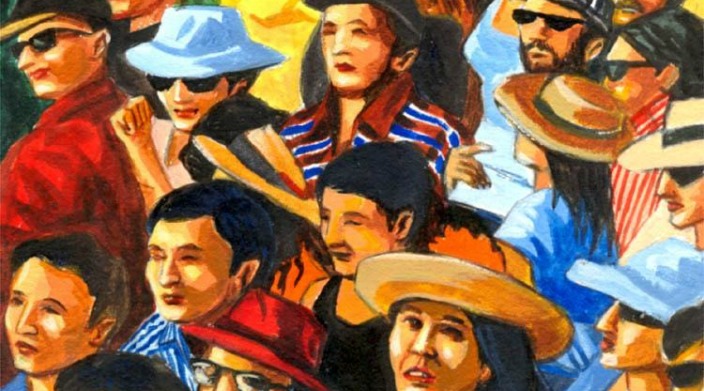
I was excited to see the new issue of Reform Judaism magazine opening with Rabbi Rick Jacobs’s message on pluralism. Rabbi Jacobs, president of the Union for Reform Judaism, writes of the loss of his “beloved teacher” Rabbi David Hartman, whose “enlightened Torah of pluralism has drawn many disciples.”
Rabbi Daniel Lehmann, president of Hebrew College (where I am a student), was also a devoted student of Rabbi Hartman. At the Hebrew College graduation ceremonies earlier this month, Rabbi Hartman was posthumously awarded an Honorary Doctorate of Humane Letters. David Hartman, Rabbi Lehmann told us, saw it as his “mission to encourage greater understanding between Jews of diverse affiliations – both in Israel and the Jewish Diaspora – and to build a more pluralistic and tolerant Israeli society.” I was inspired to hear that Rabbi Lehmann, who is Modern Orthodox, and Rabbi Jacobs, who is the leader of Reform Judaism, both felt such kinship with Hartman’s openhearted teachings.
What is pluralism? Definitions include the sociological:
- the state or condition of a common civilization in which various ethnic, racial, or religious groups are free to participate in and develop their common cultures,
- a doctrine that society benefits from such a condition;
And the philosophical:
- The doctrine that reality is composed of many ultimate substances,
- The belief that no single explanatory system or view of reality can account for all the phenomena of life.
In other words: Let’s all live together in peace, knowing that no one has a corner on the truth!
At Hebrew College, a pluralistic seminary, students are exposed to a broad spectrum of Jewish beliefs and practices, and have the opportunity to study with Jews who are Orthodox, Conservative, Reform, and Reconstructionist, as well as many who do not identify by their “denomination.” This makes for an exciting community, and a challenging one. It is not an environment of “anything goes,” but rather, “I will respect your practice if you respect mine, and I will strive to understand the value of your practice, if you strive to understand the value of mine.”
Pluralism challenges Jews from everywhere across the spectrum to learn from each other. Sometimes it is painful, as when a Modern Orthodox member of the community leads davening and chooses to use the version of the Morning Blessings in which one thanks God for being not having been made a goy, a slave, or woman (unless one is a woman, who simply thanks God for having made her the way she is). Sometimes it is exhilarating, as when graduating cantors lead an afternoon service where contemporary Reform Jewish compositions for voice and piano are cleverly woven into a Conservative cantor’s repetition of the Amidah.
Reform congregations, I believe, can be a beautiful example of a pluralistic institution. I am therefore deeply grateful that Rabbi Jacobs, leader of Reform Judaism, sees the value of pluralism. Rabbi Jacobs is looking toward Israel, but I am sure that he also understands the importance of pluralism within the Reform Movement. To be a Reform Jew in the 21st Century is not as delimited as it was 50, 100, or 150 years ago. Some wear kippot and tallitot, some do not. Some keep kosher, some do not. Some worship mostly in Hebrew, some worship mostly in English. Even more important, affiliation with a movement does not have to imply the exclusion of other expressions of Judaism. A Reform synagogue can offer services that are classical Reform, services that are influenced by the Jewish Renewal movement, and services that look very much like what happens at a Conservative synagogue. There can be a “Shabbat Alive” with a band in Friday, old-style davening on Saturday, and Kabbalah Kirtan at Motzei Shabbat. I even recently heard about a synagogue that established an “atheists’ minyan”!
In closing, let me share with you a few of the wise and witty thoughts of author Anita Diamant, who delivered the graduation address at Hebrew College this year. Diamant, a member of a Reform congregation, exhorted the graduates – whether rabbis, cantors, or Jewish educators of other kinds – to follow the advice of Rabbi Hillel: Teach everyone! She encouraged us to think of ourselves not as members of any denomination but as “Hillel’s Jews” – the ones who, as she put it, “teach outside the bimah and get outside the yeshiva.” She encourages us to see that the word “Torah” encompasses many meanings, ever-expanding from the Five Books of Moses to the teachings of Judaism over the ages, and outward to her “Chief Rabbi,” John Stewart. “You may consider my expressions to be on the fringe,” she said, smiling, “But consider – without a fringe, our tallit would be just a tablecloth!”
I was reminded that a participant in my congregation’s Tikkun Leil Shavuot service said to me, “Thanks for making a place for the fringe elements to come together in our community.” I was surprised. Like Diamant, I consider the fringe essential – not merely decorative. We are all the fringe; each of us represents a strand in the tzitztit, and without each of our disparate points of view, there would be no tallit, no congregation, and no Judaism.
Related Posts

From Scared to Sacred: Healing Our Collective Trauma in the New Year

Two Years Later: Memory and Meaning on October 7th
